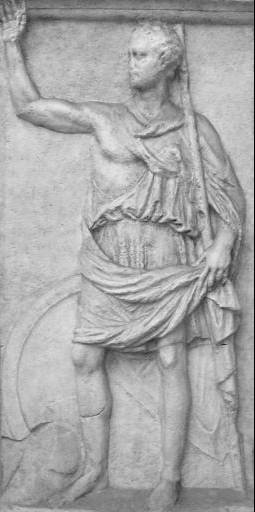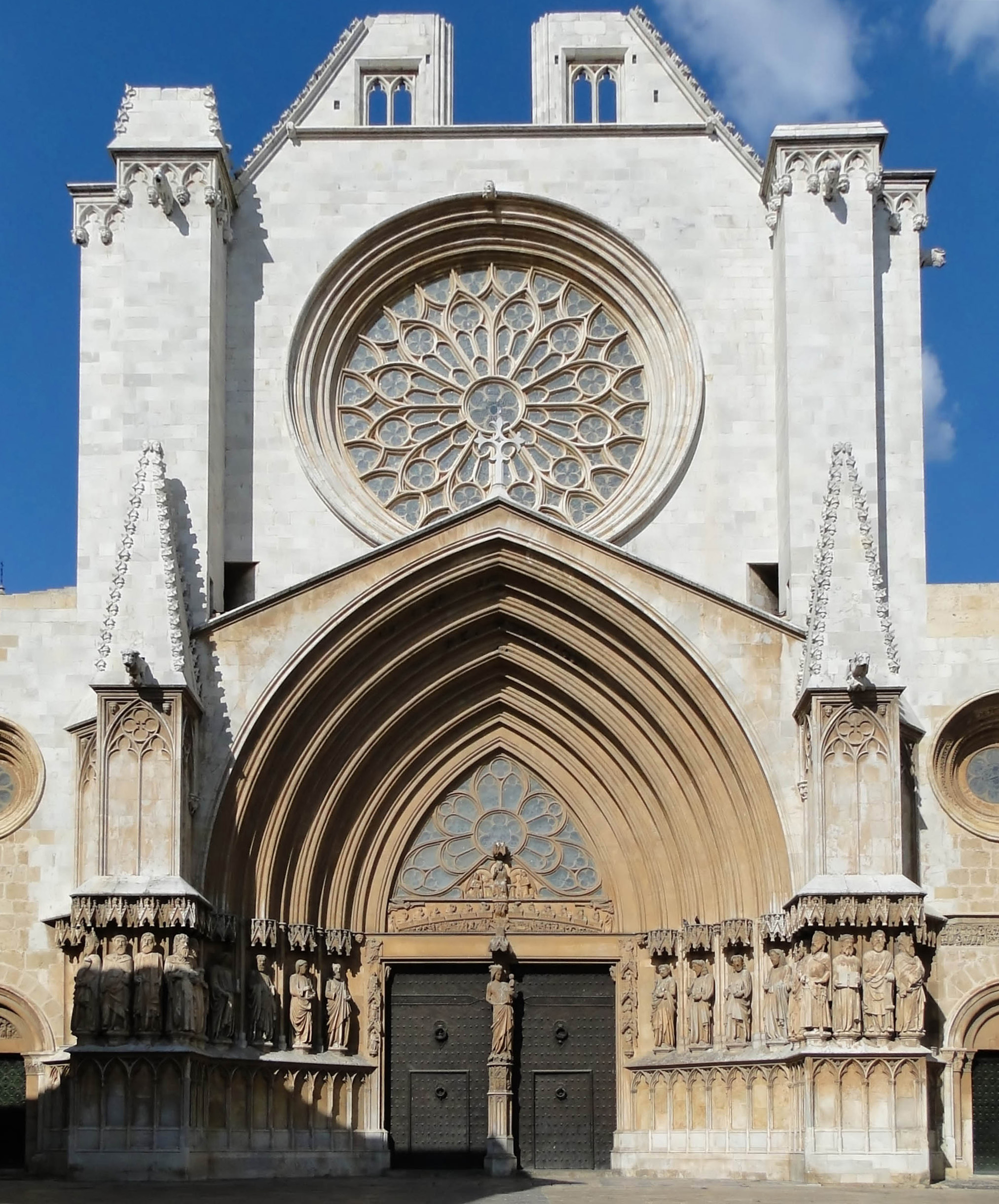|
First Celtiberian War
The First Celtiberian War (181–179 BC) was the first of three major rebellions by the Celtiberians against the Roman presence in Hispania. The other two were the Celtiberian Wars, Second Celtiberian War (154–151 BC) and the Numantine War (143–133 BC). Hispania was the name the Romans gave to the Iberian Peninsula. The peninsula was inhabited by various ethnic groups and numerous tribes. The Celtiberians were a confederation of five tribes, which lived in a large area of east central Hispania, to the west of Hispania Citerior. The eastern part of their territory shared a stretch of the border of this Roman province. The Celtiberian tribes were the Pellendones, the Arevaci, the Lusones, the Titti and the Belli. The Romans took over the territories of the Carthaginians in southern Hispania when they defeated them at the Battle of Ilipa in 206 BC during the Second Punic War (218–201 BC). After the war they remained and in 197 BC they established two Roman colonies: Hispania ... [...More Info...] [...Related Items...] OR: [Wikipedia] [Google] [Baidu] [Amazon] |
Celtiberian Wars
The First Celtiberian War (181–179 BC) and Second Celtiberian War (154–151 BC) were two of the three major rebellions by the Celtiberians (a loose alliance of Celtic tribes living in east central Hispania, among which we can name the Pellendones, the Arevaci, the Lusones, the Titti and the Belli) against the presence of the Romans in Hispania. When the Second Punic War ended, the Carthaginians relinquished the control of its Hispanic territories to Rome. The Celtiberians shared a border with this new Roman province. They started to confront the Roman army acting in the areas around Celtiberia and this led to the First Celtiberian War. The Roman victory in this war and the peace treaties established by the Roman praetor Gracchus with several tribes led to 24 years of relative peace. In 154 BC, the Roman Senate objected to the Belli town of Segeda building a circuit of walls, and declared war. Thus, the Second Celtiberian War (154–152 BC) started. At least three tribe ... [...More Info...] [...Related Items...] OR: [Wikipedia] [Google] [Baidu] [Amazon] |
Second Punic War
The Second Punic War (218 to 201 BC) was the second of Punic Wars, three wars fought between Ancient Carthage, Carthage and Roman Republic, Rome, the two main powers of the western Mediterranean Basin, Mediterranean in the 3rd century BC. For 17 years the two states struggled for supremacy, primarily in Roman Italy, Italy and Iberia, but also on the islands of Sicily and Sardinia and, towards the end of the war, in North Africa. After immense materiel and human losses on both sides, the Carthaginians were once again defeated. Macedonia (ancient kingdom), Macedonia, Kingdom of Syracuse, Syracuse and several Numidians, Numidian kingdoms were drawn into the fighting, and Celtiberians, Iberian and Gauls, Gallic forces fought on both sides. There were three main Theater (military), military theatres during the war: Italy, where Hannibal defeated the Roman legions repeatedly, with occasional subsidiary campaigns in Sicily, Sardinia and Greece; Iberia, where Hasdrubal (Barcid), Hasdru ... [...More Info...] [...Related Items...] OR: [Wikipedia] [Google] [Baidu] [Amazon] |
Lucius Postumius Albinus (consul 173 BC)
Lucius Postumius Albinus was a statesman of the Roman Republic. Family He is not to be confused with his relative (father or uncle?), Lucius Postumius Albinus, who was killed in 216 BC. He was probably a brother of Spurius Postumius Albinus Paullulus and Aulus Postumius Albinus Luscus. Career Albinus was praetor in 180 BC, and obtained the province of Hispania Ulterior. His command was prorogued in the following year. After conquering the Vaccaei and Lusitani, he returned to Rome in 178 BC, and was awarded a triumph on account of his victories. He was consul in 173 BC, with Marcus Popillius Laenas. The war in Liguria was assigned to both consuls. Albinus, however, was first sent into Campania to separate the land of the state from that of private persons, because private land owners had slowly expanded their boundaries into public land. This business occupied him all the summer, so that he was unable to go into his province. He was the first Roman magistrate who put the La ... [...More Info...] [...Related Items...] OR: [Wikipedia] [Google] [Baidu] [Amazon] |
Tarragona
Tarragona (, ; ) is a coastal city and municipality in Catalonia (Spain). It is the capital and largest town of Tarragonès county, the Camp de Tarragona region and the province of Tarragona. Geographically, it is located on the Costa Daurada area on the Mediterranean Sea, Mediterranean shore. During the period of the Roman Empire, it was one of the most prominent cities of the Iberian Peninsula, as the capital, successively, of the Roman provinces of Hispania Citerior and Hispania Tarraconensis. The Archaeological Ensemble of Tárraco, Archaeological Complex of Tàrraco is a UNESCO World Heritage Site. History Punic Etymology Ta-Aragona name in Phoenician means the Aragona, which is the native Iberian term for the Ebro Vallay. Mythical Origins One Catalan legend holds that Tarragona was named for ''Tarraho'', eldest son of Tubal in c. 2407 BC; another (derived from Strabo and Megasthenes) attributes the name to 'Taharqa, Tearcon the Ethiopian', a seventh-century BC pharaoh w ... [...More Info...] [...Related Items...] OR: [Wikipedia] [Google] [Baidu] [Amazon] |
Province Of Cuenca
Cuenca () is one of the five provinces of the Autonomous communities of Spain, autonomous community of Castilla-La Mancha. It is located in the eastern part of this autonomous community and covers 17,141 square km. It has a population of 203,841 inhabitants – the least populated of the five provinces. Its capital city is also called Cuenca, Spain, Cuenca. Geography The province is bordered by the provinces of Province of Valencia, Valencia (including its exclave Rincón de Ademuz), Province of Albacete, Albacete, Province of Ciudad Real, Ciudad Real, Province of Toledo, Toledo, Community of Madrid, Madrid, Province of Guadalajara, Guadalajara, and Province of Teruel, Teruel. The northeastern side of the province is in the mountainous Sistema Ibérico area. 211,375 people (2007) live in the province. Its capital is Cuenca, Spain, Cuenca, where nearly a quarter of the population live, some 52,980 people. There are List of municipalities in Cuenca, 238 municipalities in Cuenca. ... [...More Info...] [...Related Items...] OR: [Wikipedia] [Google] [Baidu] [Amazon] |
Province Of Toledo
Toledo () is a Province (Spain), province of central Spain, in the western part of the Autonomous communities of Spain, autonomous community of Castile–La Mancha. It is bordered by the provinces of Madrid Province, Madrid, Cuenca Province (Spain), Cuenca, Ciudad Real Province, Ciudad Real, Badajoz Province, Badajoz, Cáceres Province, Cáceres, and Ávila Province, Ávila. Its capital is the city of Toledo, Spain, Toledo. Demography Of the province's 711,228 people (2012), only about 1/9 live in the capital, Toledo, Spain, Toledo, which is also the capital of the autonomous community. The most populated municipalities in the province are Toledo and Talavera de la Reina with 83,741 and 83,303 inhabitants each (INE, 2017). The province contains 204 municipalities. The smallest municipality in Spain, Illán de Vacas, Toledo, Illán de Vacas, with a population of 3, is in Toledo province. See List of municipalities in Toledo. Population development The historical population is g ... [...More Info...] [...Related Items...] OR: [Wikipedia] [Google] [Baidu] [Amazon] |
Talavera De La Reina
Talavera de la Reina () is a city and municipalities of Spain, municipality of Spain, part of the autonomous communities of Spain, autonomous community of Castile–La Mancha. Its population of 83,303 makes it the second most populated municipality of the province of Toledo and the fourth largest in the region. Although the city straddles both banks of the Tagus, a few kilometres downstream from the junction of the former with the Alberche, most of the urbanisation concentrates on the right (northern) bank. There are two islands in the centre of the city called Isla Grande and Chamelo Island. Three bridges cross the Tagus in Talavera. The city is well known for its pottery craft. The Talavera de la Reina pottery was declared intangible cultural heritage by UNESCO in 2019. Toponymy There are remnants of prehistoric cultures in the area. The village was founded by the Celts as a ford of the Tagus. The first mention of the city (with the name ''Aebura'') occurs in Livy's description ... [...More Info...] [...Related Items...] OR: [Wikipedia] [Google] [Baidu] [Amazon] |
Carpetania
Carpetania was an ancient region of what is today Spain, located between the Sierra de Guadarrama, the mountains of Toledo, the river Guadiana and the mountain range of Alcaraz, including approximately, the present independent communities of Madrid and Castile-La Mancha. It was the most fertile part of Spain, and its name may derive from the Greek ''karpos'' meaning fruit due to abundant cultivation of fruits in the region. It was inhabited by the Carpetani, a pre- Roman tribe. To the south dwelt the Oretani, on the northeast were Celtiberians whose tribes are not further specified. On the northwest to the Vaccei and Vettones. This area was easily conquered by the Romans and quickly integrated culturally and politically. Thus, it is practically unmentioned in the literature of the conquest. It retained a distinct cultural identity through the Visogothic period. Its main urban nuclei (Toletum, corresponding to present Toledo; Complutum, the present Alcalá de Henares A ... [...More Info...] [...Related Items...] OR: [Wikipedia] [Google] [Baidu] [Amazon] |
Roman Conquest Of Hispania
The romans ruled and occupied territories in the Iberian Peninsula that were previously under the control of native Celtic, Iberian, Celtiberian and Aquitanian tribes and the Carthaginian Empire. The Carthaginian territories in the south and east of the peninsula were conquered in 206 BC during the Second Punic War. Control was gradually extended over most of the peninsula without annexations. It was completed after the end of the Roman Republic (27 BC), by Augustus, the first Roman emperor, who annexed the whole of the peninsula to the Roman Empire in 19 BC. This conquest started with the Roman acquisition of the former Carthaginian territories in southern Hispania and along the east coast as a result of defeating the Carthaginians (206 BC) during the Second Punic War (218–201 BC), after which the Carthaginian forces left the peninsula. This resulted in an ongoing Roman territorial presence in southern and eastern Hispania. In 197 BC, the Romans established two Roman pr ... [...More Info...] [...Related Items...] OR: [Wikipedia] [Google] [Baidu] [Amazon] |
Andalusia
Andalusia ( , ; , ) is the southernmost autonomous communities of Spain, autonomous community in Peninsular Spain, located in the south of the Iberian Peninsula, in southwestern Europe. It is the most populous and the second-largest autonomous community in the country. It is officially recognized as a nationalities and regions of Spain, historical nationality and a national reality. The territory is divided into eight provinces of Spain, provinces: Province of Almería, Almería, Province of Cádiz, Cádiz, Province of Córdoba (Spain), Córdoba, Province of Granada, Granada, Province of Huelva, Huelva, Province of Jaén (Spain), Jaén, Province of Málaga, Málaga, and Province of Seville, Seville. Its capital city is Seville, while the seat of High Court of Justice of Andalusia, its High Court of Justice is the city of Granada. Andalusia is immediately south of the autonomous communities of Extremadura and Castilla-La Mancha; west of the autonomous community of Region of Mur ... [...More Info...] [...Related Items...] OR: [Wikipedia] [Google] [Baidu] [Amazon] |
Hispania Ulterior
Hispania Ulterior (English: "Further Hispania", or occasionally "Thither Hispania") was a Roman province located in Hispania (on the Iberian Peninsula) during the Roman Republic, roughly located in Baetica and in the Guadalquivir valley of modern Spain and extending to all of Lusitania (modern Portugal, Extremadura and a small part of Salamanca province) and Gallaecia (modern Northern Portugal and Galicia). Its capital was Corduba. Etymology ''Hispania'' is the Latin term given to the Iberian Peninsula. The term can be traced back to at least 200 BC when the term was used by the poet Quintus Ennius. The word is possibly derived from the Punic אי שפן ''I-Shaphan'' meaning "coast of hyraxes", in turn a misidentification on the part of Phoenician explorers of its numerous rabbits as hyraxes. Ulterior is the comparative form of ulter, which means "that is beyond". According to ancient historian Cassius Dio, the people of the region came from many different tribes. T ... [...More Info...] [...Related Items...] OR: [Wikipedia] [Google] [Baidu] [Amazon] |
Valencia
Valencia ( , ), formally València (), is the capital of the Province of Valencia, province and Autonomous communities of Spain, autonomous community of Valencian Community, the same name in Spain. It is located on the banks of the Turia (river), Turia, on the east coast of the Iberian Peninsula on the Mediterranean Sea. It is the Ranked lists of Spanish municipalities, third-most populated municipality in the country, with 825,948 inhabitants. The urban area of Valencia has 1.5 million people while the metropolitan region has 2.5 million. Valencia was founded as a Roman Republic, Roman colony in 138 BC as '. As an autonomous city in late antiquity, its militarization followed the onset of the threat posed by the Spania, Byzantine presence to the South, together with effective integration to the Visigothic Kingdom of Toledo in the late 6th century. Al-Andalus, Islamic rule and acculturation ensued in the 8th century, together with the introduction of new irrigation syst ... [...More Info...] [...Related Items...] OR: [Wikipedia] [Google] [Baidu] [Amazon] |





